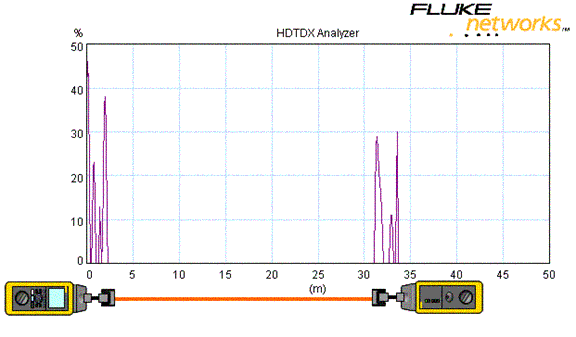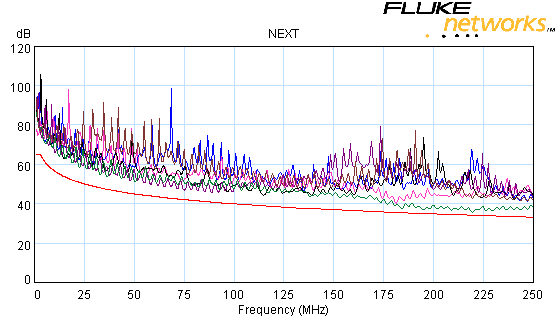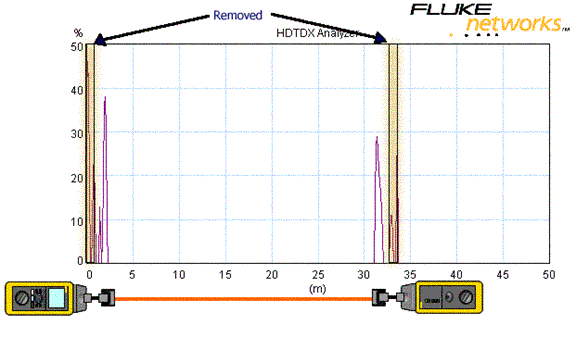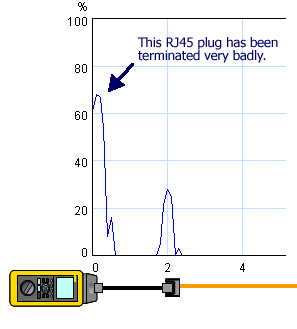Excessive Near End NEXT or Excessive Far End NEXT Message
When making a Channel Measurement, you may be presented with either of these screens at the end of the Autotest.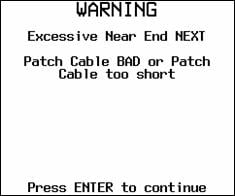 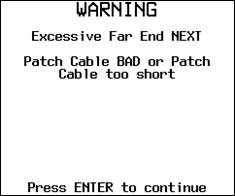 So what does Patch Cable BAD or Patch Cable too short mean? The cabling standards require tester manufacturers to exclude the connection to the tester from the measurement shown below: 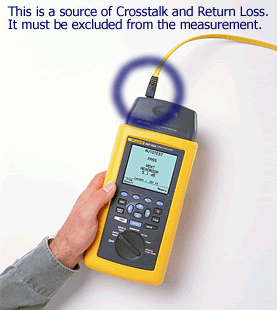 The DSP series from Fluke Networks does this using Digital Signal Processing. The measurement is first made in the Time Domain (feet and meters). Nachfolgend sehen Sie ein Beispiel:
This shows where the crosstalk is happening in the link (High Definition Time Domain Xtalk). The DSP will then convert this Time Domain Trace in meters to a Frequency Domain Plot in MHz as required by the standards for certification shown below:
However, before it converts the trace into MHz, it removes the Time Domain Xtalk in the Channel Adapters at each end. This is shown below.
Lets take a closer look at that HDTDX trace for Pairs 12,-4,5.
The result of the Autotest was a PASS. How can this be? The RJ45 plug inserted into the tester looks bad. The standards require the tester manufacturer to eliminate the connection to the tester so we did and hence it PASSed. However, because the DSP measures in the Time Domain, it sees this bad termination. If it sees excessive NEXT in the Channel Adapter, it will report either 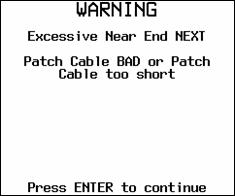 oder oder  That explains the Excessive Near End NEXT or Excessive Far End NEXT warning. So what about the or Patch Cable too short? In order to completely eliminate the NEXT in the Channel Adapter, we have to go a little beyond the Channel Adapter with the cancellation technique. NEXT in the patch cable itself is very small and stable, so removing part of the NEXT measurement in the first 70cm of the patch cable has no impact on accuracy. Even when you flex the cable the NEXT hardly changes. However, opponents to this technique in the early days created patch cords with really bad NEXT in the first 70cm. The affect of this was that the link still passed with a really bad patch cord because we ignore the NEXT in the first 70cm. An example of this specially created cord is shown below.  As a consequence, we programmed the DSP to specifically look for any unusual activity in the first 70 cm. If it sees any unusual activity such as that shown above, it will give you a warning of excessive NEXT. Fazit If you are testing a channel with short patch cords, say less than 1 meter or 3 feet, the first connector in the patch panel which has a significant source of NEXT will fall into this zone, where we are specially looking for unusual activity. If this happens, the NEXT cancellation is turned off, the above warning given and the result reported. |

